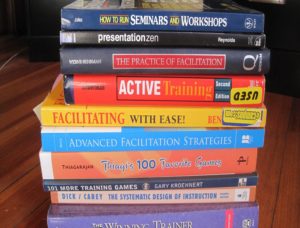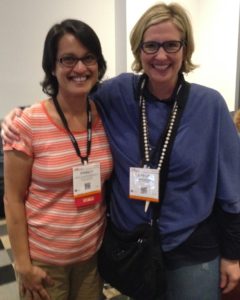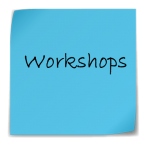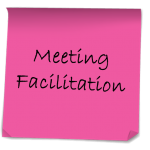No, I’m not hiring or retiring! It’s just that recently I’ve had several people contact me about getting into the field of learning and development. They ask me what they can do to become facilitators/trainers/instructors, without going back to school full time.
When faced with this request, it makes me realize once again how much I love what I do. I’m consistently energized by helping adults explore their own minds, skills, behaviors, and habits. I buoyed by the look on people’s faces when they’ve discovered something about themselves. And I’m humbled by the insightful questions and reflections shared among learners. Finally, I love observing people practice new skills that will enable them to be more successful in their lives.
Being a learning and development professional gives you an opportunity to make a difference in people’s lives. It requires curiosity and creativeness, people and problem solving skills, flexibility and feedback to others and yourself.
So here are my 5 top recommendations for learning and developing your skills in the learning and development field
1. Join the international and local chapter of ATD www.td.org
The international ATD association provides a wealth of resources including conferences, job aids, and even program designs for the new professional. I’ve attended the international conference twice. At my first conference, I was motivated by Heidi Grant Halvorson.
In one workshop, I met an amazing and talented colleague from Australia who has since become my friend. Leonie- Cutts and I bonded over a glass of wine and passionate conversation about the power of communication in workplaces and organizations across the globe. She also introduced me to her compatibility communication cards www.ccscards.com.au I’ve found great value in using these tools for conversation starters and connections in my workshops, as well as finding a colleague across the planet who can share advice on challenges and strategies in our field.
Another benefit of these conferences is the opportunity to be a presenter, if selected. I have had the opportunity to present at local, regional and the international ATD conferences. Gearing up for a presentation among your colleagues, including a group of more than 400 from around the world with my colleague Princy Quadros Mennella , certainly motived me to learn more about my subject matter (neuroscience application in the workplace) and it sharpened my presentation skills for a large international audience.
Check out any local ATD chapters in your area. In Maine, we have an active chapter that provides wonderful networking opportunities and access to varied speakers and best practices. www.maineastd.org
2. Sign up for a professional development program at a local college or university.
Instead of an advanced degree, you can get a taste of our profession and learn valuable skills through a professional development program. For example, I offer Facilitating Effective Learning Programs at the University of Southern Maine. This three-day program provides valuable and practice skills, lots of hands on practice and networking opportunities. You’re guaranteed to leave feeling more confident in your delivery skills. As a participant, you can learn from the content, your practice, and even observing what I do well (and not so well!)
3. Sign up for any course – observe and take notes on the instructor.
Whether you are taking a webinar or a face-to-face program, any time you sign up or are “volunteered” to take a learning program focus on not just the content, but also the design and delivery. Keep a piece of paper near your notes that is devoted to the instructor’s design and presentation style. Use a simple plus/delta at the top to note what you like and what could be improved. Write observable behaviors and impact. This will help you build a list of skills that you will want to demonstrate in your programs.
4. Read.
While YouTube videos and blogs are great resources, I still enjoying curling up with a good book in our field. By taking notes while I read, I enhance my memory of important practices I want to repeat. Below are a few of my favorite classic books on the learning and development field.

Training from the Back of the Room by Sharon Bowman
The Skilled Facilitator by Roger Schwarz
Active Training by Mel Silberman
Flawless-Consulting-Guide-Getting-Expertise Used by Peter Block
(I recommend Block’s book to anyone wanting to start their own learning and development business before you speak to potential clients.)
5. Offer free programs for nonprofits and at conferences and local adult-education programs in your community.
I started Catalyst & Co. www.nkacatalyst.com in 1995. While I had worked for a large health insurance company as training and development professional, my skills were not that well known in the broader community. By meeting with a few people and offering my services for free, I quickly connected to potential clients and enhanced my skills and reputation.
Connecting with nonprofits, associations, and other professional development programs can give you an opportunity to practice your skills. If things go well, ask the group leader to write you a recommendation for your LinkedIn profile or your website. Come early and stay late at the conference to network with attendees who might be willing to pay for your services in the future. Providing free programs benefits your emerging business and makes a valuable contribution to the learning in your community.








